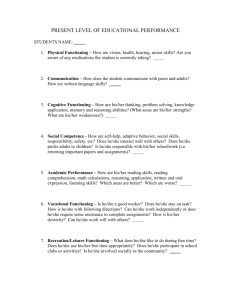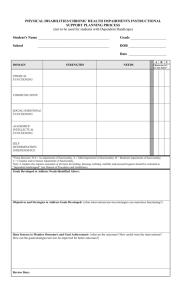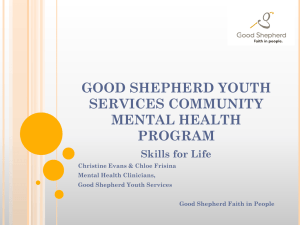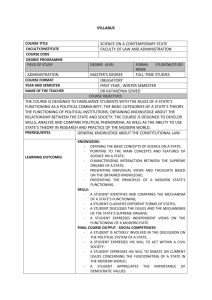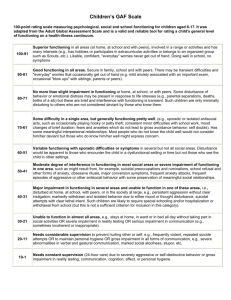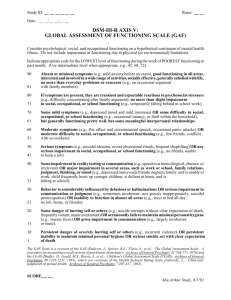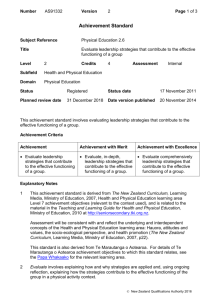Functional-Assessments
advertisement
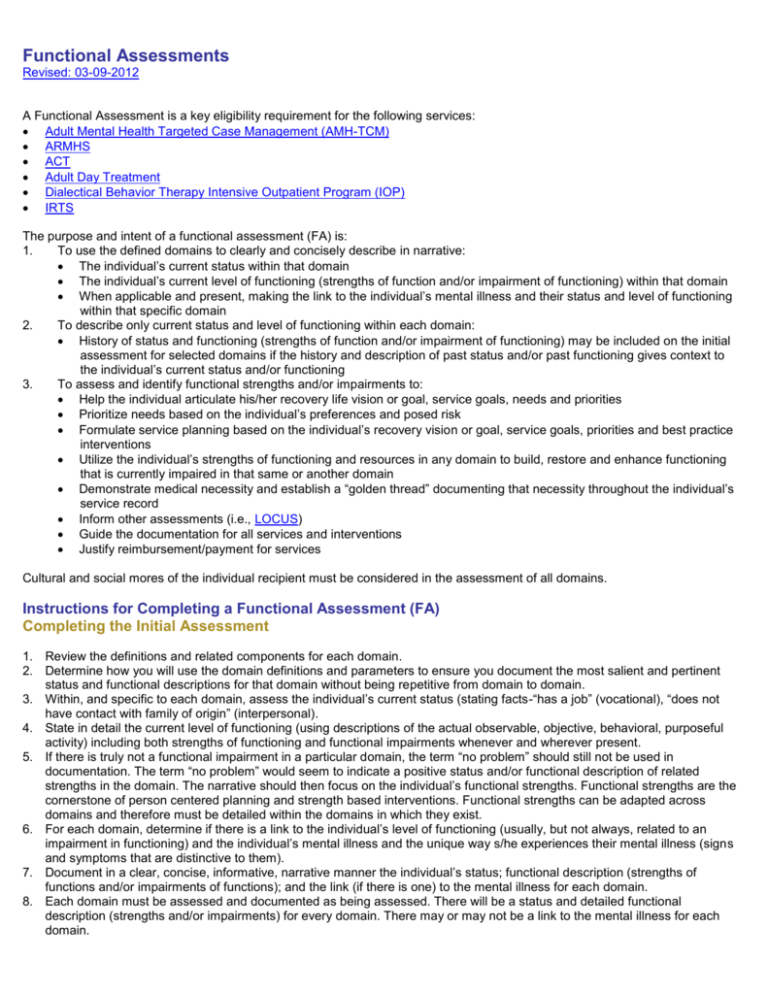
Functional Assessments Revised: 03-09-2012 A Functional Assessment is a key eligibility requirement for the following services: Adult Mental Health Targeted Case Management (AMH-TCM) ARMHS ACT Adult Day Treatment Dialectical Behavior Therapy Intensive Outpatient Program (IOP) IRTS The purpose and intent of a functional assessment (FA) is: 1. To use the defined domains to clearly and concisely describe in narrative: The individual’s current status within that domain The individual’s current level of functioning (strengths of function and/or impairment of functioning) within that domain When applicable and present, making the link to the individual’s mental illness and their status and level of functioning within that specific domain 2. To describe only current status and level of functioning within each domain: History of status and functioning (strengths of function and/or impairment of functioning) may be included on the initial assessment for selected domains if the history and description of past status and/or past functioning gives context to the individual’s current status and/or functioning 3. To assess and identify functional strengths and/or impairments to: Help the individual articulate his/her recovery life vision or goal, service goals, needs and priorities Prioritize needs based on the individual’s preferences and posed risk Formulate service planning based on the individual’s recovery vision or goal, service goals, priorities and best practice interventions Utilize the individual’s strengths of functioning and resources in any domain to build, restore and enhance functioning that is currently impaired in that same or another domain Demonstrate medical necessity and establish a “golden thread” documenting that necessity throughout the individual’s service record Inform other assessments (i.e., LOCUS) Guide the documentation for all services and interventions Justify reimbursement/payment for services Cultural and social mores of the individual recipient must be considered in the assessment of all domains. Instructions for Completing a Functional Assessment (FA) Completing the Initial Assessment 1. Review the definitions and related components for each domain. 2. Determine how you will use the domain definitions and parameters to ensure you document the most salient and pertinent status and functional descriptions for that domain without being repetitive from domain to domain. 3. Within, and specific to each domain, assess the individual’s current status (stating facts-“has a job” (vocational), “does not have contact with family of origin” (interpersonal). 4. State in detail the current level of functioning (using descriptions of the actual observable, objective, behavioral, purposeful activity) including both strengths of functioning and functional impairments whenever and wherever present. 5. If there is truly not a functional impairment in a particular domain, the term “no problem” should still not be used in documentation. The term “no problem” would seem to indicate a positive status and/or functional description of related strengths in the domain. The narrative should then focus on the individual’s functional strengths. Functional strengths are the cornerstone of person centered planning and strength based interventions. Functional strengths can be adapted across domains and therefore must be detailed within the domains in which they exist. 6. For each domain, determine if there is a link to the individual’s level of functioning (usually, but not always, related to an impairment in functioning) and the individual’s mental illness and the unique way s/he experiences their mental illness (signs and symptoms that are distinctive to them). 7. Document in a clear, concise, informative, narrative manner the individual’s status; functional description (strengths of functions and/or impairments of functions); and the link (if there is one) to the mental illness for each domain. 8. Each domain must be assessed and documented as being assessed. There will be a status and detailed functional description (strengths and/or impairments) for every domain. There may or may not be a link to the mental illness for each domain. 9. It should be noted that to meet medical necessity and eligibility for reimbursement/payment, all mental health clinical and all mental health rehabilitation service interventions must be focused on those domains where there is a functional impairment and the impairment is directly linked to the individual’s mental illness. 10. If this is an initial functional assessment for this individual or an initial functional assessment for a particular service, you may include historical status and functioning if you determine it is relevant to current status and functioning. Historical status and functioning can also be added at a later time if the information is just becoming available to the provider completing the assessment. Updating/Reassessing the Initial Functional Assessment 1. If this is an updated functional assessment, document only current status and current functioning. “Current” timeframe is defined by your service type and the time between updates. 2. Any significant changes in functioning or in an individual’s life situation and/or status, in any domain/life area, should generate a reassessment of the functional domains regardless of the due date for the of next functional assessment update. 3. Every time you do an update or reassessment, each domain must be reassessed and current status and functional description documented. 4. When routinely updating a functional assessment, there may be a limited number of domains for which there is minimal or no change between assessments. In these domains you may indicate and use the term “no change” for your functional assessment updates provided the following conditions are met: a. The status and functioning of this domain is not impacting the individual’s life or other domains; and b. Does not pose risk for the individual or c. Is not a priority for the individual; and d. Is not incorporated into service planning; and e. Is not represented by a service goal or objective; and f. Is not included or expected to be impacted by a clinical or rehabilitative intervention 5. The term “no change” cannot be used for those functional impairments which have been prioritized; are deemed to pose risk; are part of service planning, service goals and objectives, and for which clinical and rehabilitative interventions have been provided. If there truly is no change then a written narrative detailing current status and functional description must be included in these domains. 6. The term “no change” should be used very cautiously, even in the above conditions. Likewise, staff should be judicious about indicating in their narrative there is no change in domain status and functionality where they have provided ongoing intervention to build, restore, improve or enhance functioning as it indicates ineffective interventions have not been assessed and changed in a timely manner. Functional Assessment (FA) Definitions Mental Health Symptoms: This domain refers to whether or not the individual experiences current behavioral health diagnosis/diagnoses. Describe the current diagnosis/diagnoses; the specific signs and symptoms related to the diagnosis/diagnoses; and the unique ways the individual experiences the diagnosis/diagnoses. Include descriptors of which symptoms impact his/her life including those s/he is managing well and those which have negative impact on functionality in the specific domains listed below. Note: In order to substantiate a link to impairment in the life domains below, the diagnoses/related signs and symptoms must be included in this category. The individual’s past mental health history should be included in initial assessment only if it gives context to current functioning. Mental Health Services: This domain refers to what behavioral health services the individual participates in and what additional services s/he may need to support function. Include descriptors of how well the individual is able to access, engage, attend, connect, and participate in medically necessary services needed to restore and improve functionality in the life domains below. The individual’s past history securing, participating in and benefiting from mental health services can be included in the initial assessment only if it gives context to current functioning. Use of Drugs and Alcohol: This domains refers to whether or not the individual currently uses/misuses drugs and/or alcohol; what s/he uses; how much, how often and under what circumstances; and to what extent does the use of drugs and/or alcohol impact the individual’s functioning in the other life domains. Include descriptors as to how usage impacts the individual’s mental health and related signs and symptoms and to what extent the individual’s mental health and related signs and symptoms impact his/her use of drugs and alcohol. History of use/misuse, nonuse, episodes of sobriety and recovery may be included in initial functional assessment for individuals for whom use/misuse of drugs and alcohol has been an issue in the past to give context to current functioning. If applicable, identify how the individual’s mental health symptoms interfere with the individual’s ability to participate, access, engage and attend treatment for drug and/or alcohol abuse or dependence. Vocational: This domain refers to the individual’s participation in purposeful activity and/or meaningful work. Purposeful activity or meaningful work may include full and part-time employment or volunteer work on a regular or periodic basis; or production of a product or provision of a service through engagement in a structured activity which can be either externally directed by other(s) or self-directed. Structured activities may include gardening for a local farmer’s market; knitting caps for cancer patients; building bird houses for charity; reading to visually impaired, etc. Include descriptors as to the individual’s current abilities in all phases of participation in purposeful activity/meaningful work including engaging in the work; contributing to the work; and/or completing or fulfilling the goal of the activity/work. Educational: This domain refers to the individual’s participation in any relevant educational activity in multiple learning environments. These may include but are not limited to school settings, scholastic, trade; classroom or hands on experiences; formal enrollment or auditing related to skill or knowledge acquisition. This domain also includes informal learning experiences related to skill or knowledge acquisition including the individual’s ability to participate in group learning situations or other informal settings. Education activities do not need to be goal directed (degree, job) or long term but do need to be structured (by others or the individual). Include descriptors as to individual’s current abilities to engage, participate, benefit and/or complete related educational activities. Social (including the use of leisure time): This domain refers to two major functional components: social interactions and use of leisure time. Social interactions refer to the individual’s participation (active or passive interactions and interfaces) with known or unknown individuals or groups of individuals in numerous social or community settings. the individual’s social network, may include casual friends, acquaintances, colleagues, peers, providers, neighbors, contacts made using technology (blogs, Facebook, You-tube, Twitter), wait staff in restaurants, people driving or riding public transportation, shopkeepers, support group participants, staff at food banks or shelters, members of the individual’s church/synagogue/temple/mosque etc. Social contacts may be known to the individual through ongoing interactions, may be known by name or sight, or may be unknown strangers. The key is the interaction or interface in a social, non-intimate, non 1 to 1 context or in a larger group setting involving multi-personal interactions. Include descriptors as to the individual’s current abilities to read and respond to social cues and to engage, respond to and interact in social contact situations. Leisure time is defined as “free time in which the individual is free to engage in enjoyable activities with no obligations or work responsibilities.” Include descriptors as to the individual’s current abilities to identify leisure interests, plan for, engage in and participate in leisure activities. Interpersonal (including relationships with family): This domain refers to the individual’s participation (active or passive interactions and interfaces) with family (as is defined by community and the individual), close friends and the individual’s selfdefined inner circle of trusted associates. These relationships are well known to the individual through past and current contacts, ongoing one to one and small group interactions. Include descriptions of the individual’s current abilities to read and respond to interpersonal cues, to engage, respond, interact, and to participate in structured and unstructured activities as a part of these relationships. Self-Care and Independent Living Capacity: This domain refers to the individual’s participation in self-care and independent living activities. These activities may include but are not limited to activities of daily living (ADL) such as meeting nutrition needs through eating regularly, selecting, securing, preparing and safely storing nutritious food; meeting hygiene needs by regular bathing, hair washing, oral hygiene, ); meeting resource needs to maintain independent living. Independent living may also include the individual’s ability to keep themselves safe from imminent risk for harm by self or others and the ability to assess and mitigate that risk while living independently. Include descriptions of the individual’s ability to care for him/herself and to live independently based on activities detailed above (shelter, food, hygiene, risk). Medical: This domain refers to the individual’s participation in his/her medical care activities. These activities may include but are not limited to: preventive activities; determining when and how to access medical care services; making and keeping appointments; ability to engage as an active participant in medical health management (including making needs and opinions known to the health care provider); and the ability to self-direct and follow medical care interventions in order to maintain or improve physical health and/or manage known medical conditions and/or diseases. This may include monitoring blood pressure; maintaining a low sugar, low fat diet; exercising; maintaining weight, etc. Include descriptors of the individual’s ability to perform the related activities above in regards to medical care (identifying need, making and keeping appointments, following through on recommendations, participating in self-directed care and activities, etc.). This domain may also include the individual’s ability to maintain access to health care. This can include the individual’s ability to navigate the health care system, regarding both access to providers and access to health care benefits. Dental: This domain refers to the individual’s participation in his/her dental care activities. These activities may include but are not limited to preventive activities; determining when and how to access dental care; making and keeping appointments; ability to engage as an active participant in dental health management including making needs and opinions known to the dental health care provider; and the ability to self-direct and follow dental care interventions to meet needs, to maintain or improve dental health, and/or to manage known dental conditions and/or diseases. Include descriptions of the individual’s ability to perform the related activities above in regards to dental care (identifying need, making and keeping appointments, following through on recommendations, participating in self-directed care and activities, etc.). This domain may also include the individual’s ability to maintain access to dental health care including the individual’s ability to navigate the dental health care system both regarding access to providers and access to dental health care benefits. Financial: This domain refers to the individual’s participation in personal finance related activities. These activities include but are not limited to identifying financial resources and securing entitlements or payee functions. This domain also encompasses the much broader category of financial management and the abilities needed to manage finances independently. This can include: whether the individual is currently managing their own financial resources; what abilities s/he has for self-management in having sufficient financial resources; and in managing resources independently. Include necessary budgeting skills not included in selfcare/independently domain. Housing: This domain refers to the individual’s participation in housing related activities. These activities include, but are not limited to identification of lack of housing resources and the securing of housing by others for the individual. Information about the of the individual’s current housing status such as housing needs and resources; housing (non-housing) preferences may be identified. Descriptors which identify the individual’s challenges related to stable housing; how whether the individual is currently managing their own housing resources; and what abilities s/he has for self-management in having sufficient housing resources and in managing those resources independently. Descriptors may also include the individual’s challenges related to maintaining housing arrangements where the individual might otherwise have access to housing with others (examples include: communication skills or lack thereof, anger management issues, relationship problems, trust issues.) Include functioning descriptors around necessary independent living skills which affect potential loss of housing; meeting needs for safe and adequate shelter through securing, organizing and maintaining that shelter; and/or safety and security risk with current housing setting not included in self-care/independently domain. Transportation: This domain refers to the individual’s participation in transportation activities. These activities may include but are not limited to: knowledge and ability related to general access to and availability of public and private transportation in his/her community; determining modes of transportation available; identifying and securing resources (financial, tokens, people) needed to use transportation; accessing specific types of transportation (bus, train, car, taxi, and/or van service, private car driven by friend or volunteer); and the activities and skills needed to do so- e.g. reading and following a bus/train schedule, calling taxi/van transportation dispatch, contacting a friend, neighbor or volunteer. Include descriptors of the individual’s ability to perform the related activities above as well as level of functioning in following schedules, making, being ready and keeping transportation appointments, interacting and interfacing with those providing transportation and in the case of public transportation- interacting and interfacing with those using transportation while waiting in bus/train queues; riding as passenger, etc. Descriptors may also include the individual’s challenges related to group transportation methods which may include interpersonal skills, hygiene skills, social skills, and symptom management in group or public settings. Descriptions may also include the individual’s judgment around transportation safety. Other: This is an optional domain. Suggested topics for this domain may include but are not limited to: legal; risk for harm (self/others) including self-injurious behaviors; spirituality; language; immigration acclamation; transition to adulthood; cognitive abilities; additional co-occurring issues (besides chemical use and physical health), etc. As in all domains, it is expected the domain be clearly defined and include the individual’s current functioning, strengths and/or impairments. History of function may be included in the initial assessment, or as information is obtained, if it lends context to current functioning. Legal References MS 245.462, subd. 11 (a)
